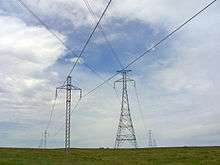CU (power line)
CU is the designation of a line for high-voltage direct current (HVDC) transmission between the Coal Creek Station power plant south of Underwood, North Dakota at 47°22′24″N 101°9′23″W / 47.37333°N 101.15639°W and the Dickinson converter station near Rockford, Minnesota at 45°06′40″N 93°48′36″W / 45.11111°N 93.81000°W.
The designation most likely refers to two Minnesota-based power generation/transmission cooperatives that originally partnered to build the Coal Creek plant and associated line - Cooperative Power Association and United Power Association, which later merged to become Great River Energy.
The CU project controversy in 1978 and 1979 was a result of protests by farm landowners in the path of the CU line right of way.
The CU line, which went in service in 1978, can transfer an electrical power of 1,000 megawatts at a symmetrical transmission voltage of 400 kV. An overhead line connection 436 miles (710 kilometers) long is used, with two conductors per pole. Thyristor static inverters are used.[1]
Crossing of HVDC powerlines
Southwest of Wing, North Dakota, at 47°02′48″N 100°05′49″W / 47.04667°N 100.09694°W CU crosses Square Butte, another HVDC powerline. This is the only crossing point of two HVDC overhead powerlines in the Western hemisphere.

Electrodes
The ground return electrode line at Coal Creek Station uses the towers of the AC line between 47°22′28.01″N 101°9′47.65″W / 47.3744472°N 101.1632361°W and 47°22′43.03″N 101°10′4.94″W / 47.3786194°N 101.1680389°W as support before it ends at 47°24′53.2″N 101°13′40.81″W / 47.414778°N 101.2280028°W.
The electrode line at Dickinson converter plant runs on the towers of the main line until a tower at 45°9′27.81″N 94°2′15.06″W / 45.1577250°N 94.0375167°W. From this tower it runs on a line on 4 poles until its endpoint situated at 45°9′33.73″N 94°2′23.74″W / 45.1593694°N 94.0399278°W.
References
- ↑ http://web.archive.org/web/20050526185217/www.transmission.bpa.gov/cigresc14/Compendium/CU.htm CU project description, retrieved 2010 June 8